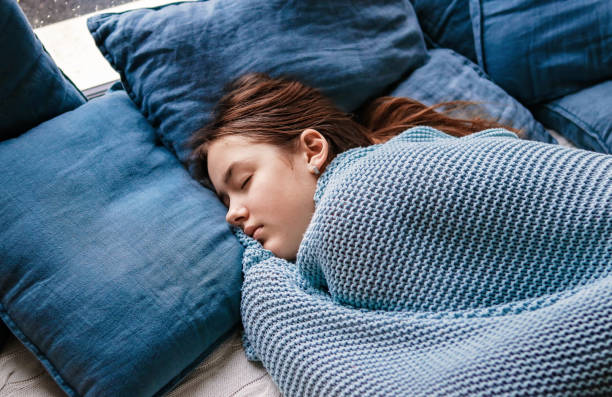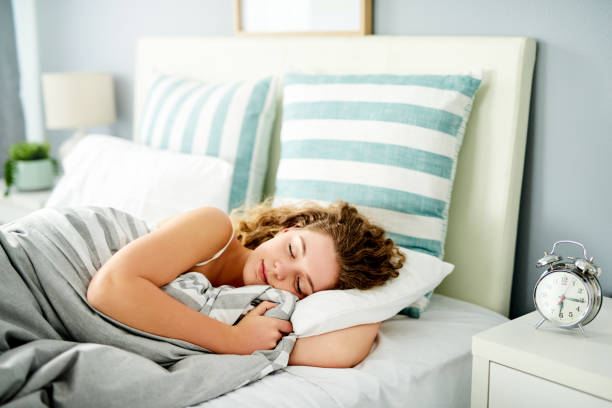When you have a cold, sleeping can be difficult. In addition to making breathing difficult, symptoms like a stuffy nose and coughing can keep you awake.
But for recovery, a good night’s rest is crucial. To heal, your body requires rest.
Thankfully, there are methods to momentarily reduce your symptoms and get the rest you require. Continue reading to discover more about how to sleep while suffering from a common cold.
Table of Contents
Why Can’t I Sleep With a Cold?
In addition to the common cold symptoms of a headache, sore throat, and blocked nose, you typically feel generally under the weather when you have a cold. However, lying down physically can exacerbate those symptoms.
Although cold may cause you to produce more mucus than usual, the inflamed blood vessels inside your nasal passageways are what actually cause your blocked nose. Because of the position and the change in blood pressure that occurs when you lie down, more blood will flow to your upper body. Your blood vessels may become inflamed as a result of this increase, narrowing your nasal passages. As a result, it will be more difficult for you to breathe and you will feel more congested.
Lying down makes it difficult for you to clear your sinuses and nose of mucus. This is due to the fact that when you’re standing or sitting upright, gravity naturally causes mucus to run down your nose or to the back of your throat where it can be swallowed. This is typical and occurs every day, but it is more obvious when you are sick. The mucus in your throat may pool while you’re lying down, giving you a “bunged up” feeling or making you cough. Another name for this is post-nasal drip.
Tips to Help You Sleep With a Cold
The Best Position to Sleep With a Cold
When you’re congested, try sleeping on your side with pillows supporting you. The accumulation of postnasal drip will be lessened, your nose won’t feel congested, and breathing will be easier as a result. When you lie down, use a few pillows to support your neck and make sure it is not twisted awkwardly. Just two pillows should be used for sleeping, according to Healthline.
Take Medication
Taking the right medication can help relieve symptoms of cold, congested sinuses, or congestion, allowing you to feel at ease and ready for bed. Always read the description to try to match the medication to your symptoms rather than taking “catch-all” tablets. Avoid taking drugs that contain caffeine, which will keep you awake. These drugs are typically marketed as “non-drowsy.”
Have a Hot Shower Before Bed
According to studies, taking a bath or shower and allowing yourself enough time to cool off can help you fall asleep. In addition to making you feel calm and prepared for bed, the steam from the shower will aid in clearing your airways and opening up your nasal passages. To help you breathe more clearly and to loosen any dried mucus, take a few deep breaths while keeping your face near the water.
Drink Herbal Tea
In keeping with the steam theme, hot drinks or soup can help open your nasal passages in a similar manner to a shower. Consider a calming tea, such as chamomile, mint, or lavender, before going to bed. These won’t make you jittery before bed because they don’t contain caffeine.
Optimize Your Sleep Environment
When you’re feeling under the weather, it’s all too easy to turn up the heat, layer up, and huddle under a blanket. However, if you do this, you’ll probably wake up in the middle of the night sweating and uncomfortable, gasping for air. The ideal sleeping temperature, according to Sleep.org, is between 60 and 67 degrees Fahrenheit (15 to 20 degrees Celsius).
If you’re having breathing problems, use a humidifier or vaporizer. Your throat and nose won’t feel dry and sore as a result of the moisturizing effect on the air. Make sure to clean it frequently to prevent the growth of bacteria and mold, which could lead to further illness.

Try Not to Toss and Turn
After 10 or 20 minutes of lying in bed, if you still can’t fall asleep, get out of bed and do something calming like reading, gentle yoga, or meditation. As soon as you start to feel sleepy, you can return to bed and fall asleep more soundly.
Soothe a Sore Throat
Before going to bed, gargle with warm salt water for immediate relief. Throat sprays, painkillers, and over-the-counter lozenges are other options. In particular, if you don’t have typical cold symptoms like congestion and sneezing, tell your doctor if you have a severe sore throat and a fever for longer than two days. A strep infection might be to blame.
Use Nasal Strips
These adhesive strips are used by some people to relieve congestion while they sleep. Your nasal passages will be stretched and opened as a result of their passage across the bridge of your nose. Mucus won’t be broken up by a strip, but it might create a little more airflow.
Sleep on Schedule
With a cold, it may be difficult to adhere to a regular bedtime. However, it’s preferable to get up and go to bed at the same time every day. Not only does following a schedule make it simpler to fall asleep, but it can also help you avoid getting sick in the future. According to one study, those who get 8 or more hours of sleep per night are less likely to get the flu than those who don’t get enough zzzs.
Stay Hydrated
When you are ill, doctors frequently advise drinking a lot of fluids and staying in bed. It’s crucial to drink more water when you have a cold because your body loses water as a result of sweating, producing mucus, and other immune reactions. Just be careful not to drink too much before bed or you might find yourself waking up frequently during the night to use the restroom. The evening is a great time to relieve your sore throat from cold symptoms by drinking a hot, caffeine-free tea or other beverage.
Breathe in Steam
You might find it more comfortable to breathe while you sleep if you gently inhale steam or use a humidifier to help with stuffy nose symptoms. Avoid letting the air become overly humid, and stop using the humidifier if you notice that it makes your asthma or allergy symptoms worse.
Try taking a warm shower right before bed if you don’t have a humidifier. Taking a warm shower before bed not only creates warm steam but also naturally gets your body ready for sleep by regulating core body temperature.

Is It Dangerous to Sleep With a Blocked Nose?
It is nothing to be concerned about to sleep with a cold and a blocked nose; in fact, it is quite typical, especially in the winter. Although it may be uncomfortable and interfere with your sleep, we are confident that a few changes to your sleep schedule will help you feel better. Healthline advises you to always seek medical advice from your doctor if your cold and nasal congestion worsens after a week and you start to experience discharge, a high fever, and breathing difficulties. These might indicate the presence of a more serious condition than a common cold.
Can Sleep Cure a Cold?
Sadly, there is no miracle cure if you’re looking for a way to get rid of a cold quickly overnight. However, getting a good night’s sleep can help with the healing process and is crucial for fighting off a cold.
Sleep aids in the body’s ability to combat the infection that is making you feel unwell, says Neelam Taneja-Uppal, MD. It’s no secret that your body repairs and recovers from everything that happened during the day while you sleep. Additionally, while your body is being rested during sleep, your body has the time and room to recover from illness.
Summary
Most cold symptoms last between seven and ten days. Due to congestion, coughing, or a runny nose, you might occasionally find it difficult to get a good night’s sleep.
Fortunately, there are methods to alleviate your symptoms. Medications like NSAIDs, cough syrups, or nasal decongestants are some options. Natural remedies like hot drinks, saltwater gargles, hot showers, and stacked pillows are additional options.
Some advice may work better than others for you depending on your symptoms. Be sure to follow up with a healthcare professional if your cold worsens or lasts longer than 3 weeks.
